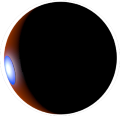Announcing the Mars Terraformer Transfer (MATT).
A commercial satellite can terraform a site on Mars in 2036.
March 21, 2017 – The Lake Matthew Team today announced the Mars Terraformer Transfer (MATT), the first practical terraformation invention. With MATT a commercial satellite terraforms a region of Mars in 2036, creating a persistent lake for use by mission crews. The invention is patent-pending and available for licensing.
Continual inhabitation of Mars is a goal shared by many national space agencies and aerospace firms. The physical and financial challenges are daunting, but they can be ameliorated with terraformation, Martyn Fogg’s notional “process of planetary engineering” in support of life. Terraformation need not engineer an entire planetary surface. A city-region is adequate for inhabitation. MATT hits this mark.
MATT details methods for a 2036 terraformation, completed in good time to assist early mission crews. One commercial satellite executes the mission plan. It’s a Shepherd, guiding a selected celestial small-body impactor to a selected target site. A DE-STARLITE-class fiber laser provides the shepherding impulse. The laser and other commercial instruments deflect, analyze and restructure the small body, over some years, for optimized impact on Mars. The mission plan is unobvious but straightforward, specific and feasible. At least six U.S. firms have the demonstrated capability to build the required Shepherd, using off-the-shelf hardware, at this time.
The impactor injects heat into bedrock, producing meltwater for a lake that persists for thousands of years within the warmed impact site. Here the challenges of crewed missions are ameliorated, and the achievable scale of inhabitation is increased. Whereas prior designs of habitation structures (habs) were limited to thousands of cubic meters, MATT habs can scale to millions of cubic meters – stadium scale, or greater. The site’s treated lake water is sufficient to cover and protect subaqueous domes. Such habs are not pressure vessels; therefore the size-limiting scaling laws of pressure vessels do not apply, and habs scale to match ambitions. With scaling the first Mars habs transition quickly into settlements, with capacity for self-sufficiency, even provisioning of expeditions worldwide. This cuts the Earth-shipped cargo mass, and the expense, of crewed missions.
Scaled habs can also house commercial offices for telerobotic open-pit mining of rare and rare earth metals. High-grade ore deposits are likely abundant in the martian near-surface, mainly in the preserved mass of protoplanetary-core asteroids like 16 Psyche. Such asteroids would enrich ancient martian impact sites with metal ores, rendering Mars the greatest treasury of accessible rare and rare earth metals in the solar system. MATT opens this treasury.
MATT is necessarily a strategic invention, designed to accelerate Mars exploration, settlement and commercial development. All recovered resources are controlled by the MATT licensee, pursuant to the U.S. Commercial Space Launch Competitiveness Act.
For more information on MATT, see LakeMatthew.com.
Contact: LakeMatthewTeam@gmail.com
